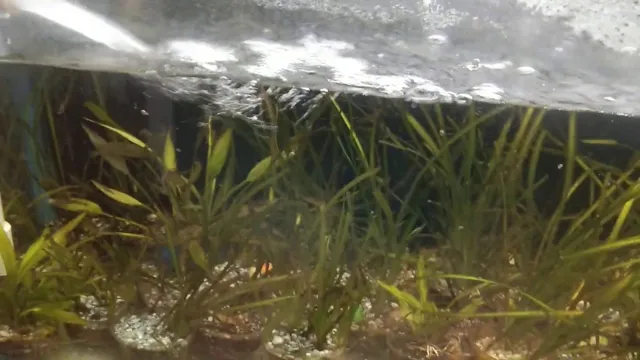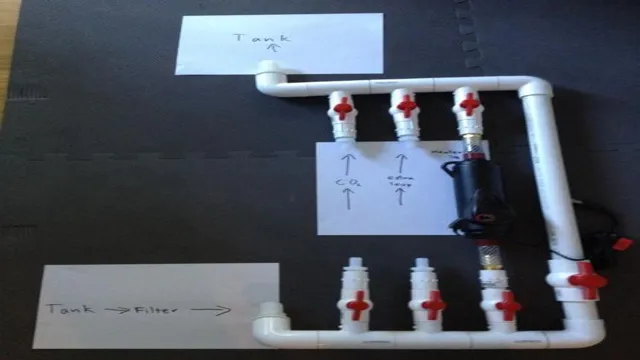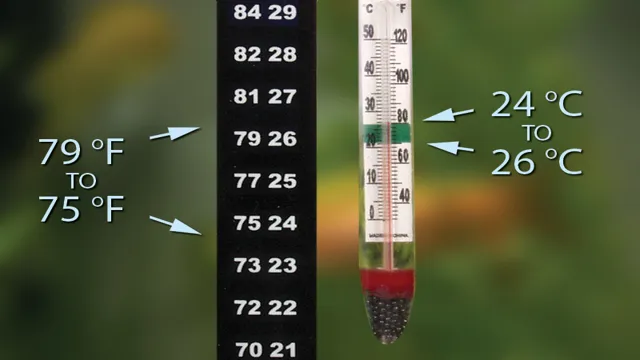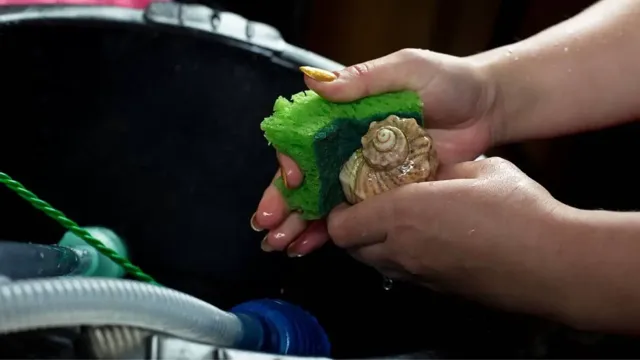Are you tired of having unsightly algae take over your aquarium? It’s a common problem among fish enthusiasts, but luckily there are ways to combat it. Algae can not only be an eyesore, but it can also be harmful to your fish if left unchecked. In this blog, we’ll explore different types of algae and how to prevent and remove them from your aquarium.
From understanding the causes of algae growth to the best cleaning methods, we’ll cover everything you need to know to maintain a healthy and beautiful aquarium environment. So, grab a cup of coffee and let’s dive in!
Understanding Algae
Dealing with algae in an aquarium can be frustrating for any fish owner. However, understanding what causes algae growth is crucial to preventing and resolving the issue. Algae thrive in environments with excess nutrients such as nitrogen and phosphorous.
Overfeeding your fish and inadequate water changes can lead to an abundance of these nutrients and promote algae growth. Proper cleaning and maintenance routines are essential to keeping algae at bay. Also, limiting the amount of light exposure to your tank can help control algae growth.
If you still find yourself struggling with a persistent algae problem in your aquarium, there are various treatments available such as algae-eating fish, UV sterilizers, and chemical additives. Overall, maintaining a healthy and balanced aquatic ecosystem will help prevent and alleviate any issues with aquarium algae.
What is Aquarium Algae?
Aquarium algae is a common problem that many fish keepers face. But what exactly is algae? Algae are aquatic organisms that can range in size from tiny single-celled microalgae to larger seaweeds. Although many fish keepers associate algae as a nuisance that makes their aquarium look dirty, algae serve an important role in aquatic ecosystems as they provide food and oxygen for aquatic organisms.
However, when aquarium algae reaches a point where it becomes excessive, it can cause harm to the ecosystem and affect the health of the fish. In order to prevent and manage aquarium algae growth, it is important to understand the different types of algae and what conditions favor their growth. By maintaining balanced water parameters and implementing proper aquarium maintenance practices, aquarium algae can be effectively controlled and prevented.

Types of Aquarium Algae
Algae is a common sight in aquariums, and while some people may find it unsightly, it actually plays a vital role in the environment of your tanks. Algae growth can be the result of many factors such as lighting, water chemistry, and feeding routines. Understanding the types of algae that can grow in your aquarium is essential in preventing or fixing any issues that may arise.
There are three main types of algae: green algae, brown algae, and red algae. Green algae generally grows due to an excess of nutrients in the water, and it often appears as a green coating on rocks, glass, or plants. Brown algae, on the other hand, is often caused by changes in lighting and can appear as a thin coating on aquarium glass or decorations.
Red algae, also known as cyanobacteria, is a type of bacteria that can grow in aquariums with high levels of phosphates or nitrates. By familiarizing yourself with the different types of algae and their causes, you can take steps to manage and prevent their growth in your aquarium.
What Causes Algae to Grow?
Algae growth is a common issue that many pond and aquarium owners face. Algae are tiny aquatic plants that can grow rapidly in water. They usually thrive in areas with favorable conditions like sunlight, nutrients, and moisture.
When algae experience favorable conditions, they grow at a rapid pace, resulting in overgrowth or blooms that can be detrimental to aquatic life. Some of the common reasons why algae grow include excess nutrients in the water, exposure to sunlight, and warm temperatures. Nutrient-rich water, especially in the form of phosphorus and nitrogen, acts as food for algae, encouraging their growth.
Sunlight is also essential for photosynthesis, allowing the algae to produce their food. In addition, warm temperatures accelerate their metabolic activities, resulting in rapid growth. To prevent algae growth, it is crucial to maintain a balance between sunlight exposure, nutrient supply, and water temperature.
This can be achieved by proper cleaning, filtration, and treatment of water. By keeping the water free from excessive nutrients and limiting sunlight exposure, algae growth can be significantly reduced.
Preventing Algae Growth
Having algae growth in your aquarium can be frustrating, but there are a few ways to prevent it. First, make sure not to overfeed your fish as excess food can lead to excess nutrients that algae thrive on. You should also regulate your lighting and the duration of it each day.
Algae love light and leaving it on for too long can encourage growth. Changing the water regularly is another critical step in maintaining a healthy aquarium. Not only will it prevent algae growth, but it will also remove any excess nutrients and waste products that could lead to other health problems for your fish.
Lastly, consider adding in some live plants to compete with the algae for nutrients and resources. While it may take some time to find the perfect balance, taking these preventative measures can keep your aquarium looking beautiful and your fish healthy. (See Also: How to Maintain Sand in Aquarium: Tips and Tricks to Keep Your Tank Clean and Healthy)
Maintain Proper Lighting
If you’re struggling to keep your aquarium’s water crystal clear, algae may be to blame. One way to prevent algae growth is to maintain proper lighting. Algae thrive in light, so it’s important to make sure your tank isn’t getting too much of it.
This can be achieved by placing your aquarium away from direct sunlight and using a timer for your tank’s lighting. Overexposure to light can also cause stress for your fish and other aquatic life, so it’s crucial to find a balance. Regularly cleaning your tank’s lighting fixtures can also help prevent algae growth by ensuring they’re not blocked by dust or debris.
By taking these steps, you can keep your aquarium looking beautiful and healthy for your aquatic pets to thrive in.
Control Feeding
When it comes to preventing algae growth in your pond, control feeding is a crucial step. Overfeeding fish can lead to a build-up of excess nutrients in the water, which provides the perfect environment for algae to thrive. To avoid this, it’s essential to feed your fish the right amount of food at appropriate intervals, based on their size, age, and metabolism.
Avoid feeding them more than they can eat in a few minutes, and remove any leftover food after feeding. This will not only help to prevent algae growth but also improve the overall health of your fish by promoting a balanced diet and reducing the risk of overconsumption. By keeping the feeding under control, you can keep your pond clean and beautiful, without having to worry about unsightly algae.
Regular Water Changes
One of the most effective ways to prevent algae growth in your aquarium is by performing regular water changes. Algae thrive in water that is stagnant and lacks fresh oxygen, so changing out a portion of the water on a weekly or bi-weekly basis can significantly reduce the likelihood of algae blooms. Aside from decreasing the available nutrients in the water that algae feed on, water changes also help to dilute any harmful pollutants or debris that may accumulate over time.
It’s important to use a water conditioner to neutralize any chlorine or other chemicals present in the tap water before adding it to the aquarium. By establishing a routine of regular water changes, you can ensure a healthy and flourishing aquatic environment for your fish and plants to thrive in.
Use Algae Eaters
Algae growth in aquariums can be frustrating, but there’s an effective solution – algae eaters. These small fish or invertebrates are natural predators of algae, making them ideal for keeping your aquarium algae-free. Not only do they consume algae, but they also help maintain a healthy balance in the tank’s ecosystem.
Algae eaters come in a variety of types including snails, shrimp, and fish like plecos or otocinclus. Before adding algae eaters, research the specific needs of your tank to ensure they are compatible with your other aquatic pets. It’s important to note that algae eaters shouldn’t be relied upon as the sole solution for controlling algae growth.
Proper tank maintenance and proper feeding are also crucial to keeping your aquarium healthy and algae-free. With the help of algae eaters and some mindful care, you can have a thriving, vibrant aquarium.
Removing Algae
Having an aquarium can be a beautiful addition to any living space. However, one issue that many aquarium owners face is dealing with algae. Algae growth is common in aquariums, but too much of it can harm the health of your fish and make your aquarium look unsightly.
There are several ways to remove algae from your aquarium, and it’s essential to find the method that works best for your specific situation. One effective way to deal with aquarium algae is to have a proper maintenance routine. Regularly cleaning the tank and changing the water can help prevent algae growth.
Another method is to add algae-eating fish or snails to your aquarium. These organisms can help keep the algae growth under control. You can also purchase a wide variety of algae scrubbers, filters, and chemical treatments to help combat the problem.
By taking the necessary steps to keep your aquarium healthy and clean, you can prevent harmful algae growth and keep your tank looking beautiful.
Manual Removal Methods
When it comes to removing algae from your pond or water feature, there are various manual removal methods that can effectively get the job done. One of the most common methods is using a net or rake to physically remove the algae from the water. This works best for string algae or other types of algae that tend to clump together.
Another method is using a brush or scrubber to manually clean the surface of the water feature. This is particularly effective for removing algae that forms on rocks or other surfaces. It’s important to note that manual removal methods should be used alongside other preventative measures, such as proper filtration and nutrient control, to ensure that the algae doesn’t simply return. (See Also: How to Get to Sydney Aquarium: The Ultimate Guide for Locals and Tourists Alike)
Ultimately, with patience and persistence, manual removal methods can be an effective way to keep your water feature clean and clear of algae.
Chemical Removal Methods
Removing algae from a pond or water body can be a challenging task, but it’s essential to maintain a healthy ecosystem. One effective way to remove algae is by using chemical treatments. These treatments come in different forms, such as algaecides and herbicides, and work by breaking down the algae’s cells.
However, it’s essential to be cautious when using these chemicals as they can harm other aquatic life and have long-lasting effects on the environment. Before using any chemical treatments, it’s always recommended to consult a professional to determine the right product for your specific situation. Ultimately, by using these chemical removal methods, you can help maintain a balanced ecosystem and keep your pond or water body clear of unwanted algae.
Biological Removal Methods
When it comes to removing algae, there are a few biological methods that can be effective. One of them is using grazing fish to consume the algae. Some common grazing fish include tilapia, carp, and catfish.
These fish can be added to a pond or other body of water and left to consume the algae. Another method is through the use of bacteria. Certain strains of bacteria, such as those found in Bio-Zyme, can break down the organic matter in the water, including algae.
Additionally, aquatic plants, like duckweed and water hyacinths, can also be used to absorb excess nutrients in the water and prevent algae from growing. However, it is important to note that these methods may not work for all types of algae and should be used in combination with other removal techniques. Overall, utilizing biological methods to remove algae can provide a natural and effective solution for maintaining a healthy aquatic environment.
Maintaining Your Aquarium
Dealing with aquarium algae is a common problem for many fish enthusiasts. Luckily, there are a few ways to maintain a clean and healthy tank. Firstly, it’s important to regularly clean your tank and perform water changes.
This helps remove any excess nutrients that algae feed off of. Secondly, you could try adding an algae-eating fish like Otocinclus or a few Amano shrimp, which can help keep the algae growth under control. Furthermore, you can use natural remedies like reducing the amount of light exposure.
Finally, you could invest in a UV sterilizer, which can destroy algae spores and help prevent future growth. By regularly monitoring and maintaining your aquarium, you can enjoy a clean and healthy home for your fish.
Regular Cleaning Schedule
Maintaining a clean and healthy aquarium is crucial to the well-being of your aquatic pets. One of the most important aspects of upkeep is establishing a regular cleaning schedule. This involves not only routine water changes but also maintenance of the aquarium’s filtration system, live plants, and decorations.
A proper schedule will vary depending on the size of the tank and the number of inhabitants it contains. Generally, you should aim to change 10-20% of the water weekly and clean the filter monthly. Don’t forget to inspect the tank for any signs of algae growth or debris buildup and address them promptly to prevent any harmful effects on your aquatic pets.
Also, ensure that the temperature and pH levels are consistent and appropriate for the species you are keeping. By implementing a regular cleaning schedule, you can keep your aquarium healthy and beautiful for years to come.
Avoid Overcrowding
Maintaining Your Aquarium and Avoiding Overcrowding Keeping your aquarium tidy and well-maintained is essential for the health of your fish and other aquatic organisms. One of the key factors to consider is overcrowding. While it may be tempting to add more fish or other creatures to your aquarium, too many can cause stress and even disease.
Overcrowding can also lead to a buildup of waste and toxins, which can harm the inhabitants of your aquarium. To avoid overcrowding, it’s essential to research the specific needs and behaviors of each aquatic creature you plan to add and make sure they’re compatible with each other. Additionally, monitor the water parameters and perform regular water changes to keep the water clean and healthy.
Remember, a happy and healthy aquarium requires balance, not abundance. So, take the time to properly care for your aquarium to ensure the welfare of its inhabitants.
Maintain Proper Water Parameters
Maintaining Your Aquarium: Maintain Proper Water Parameters Keeping proper water parameters is crucial for the health and well-being of your aquarium inhabitants. First and foremost, you need to monitor the temperature, pH level, and water hardness. A combination of test kits and electronic monitors will help you keep track of these parameters and make any necessary adjustments. (See Also: How to Drain an Aquarium on the Floor: The Complete Guide for Beginners.)
You should also be mindful of the nitrogen cycle in your aquarium, which involves beneficial bacteria breaking down waste products into less harmful forms. To maintain a healthy nitrogen cycle, you should regularly test for ammonia and nitrite levels, and perform partial water changes as needed. Additionally, consider the type and number of fish and plants in your aquarium, as overcrowding can lead to issues with water quality.
With proper attention to water parameters, you can help ensure a thriving and vibrant aquatic environment for your pets.
Test Water Frequently
If you want your fish to thrive in their aquarium, one essential tip is to test the water frequently. Ammonia, nitrate, and pH levels are all critical to ensuring a healthy environment for your aquatic pets. Regular testing will help you identify issues early and prevent potential complications.
You can purchase aquarium test kits from pet stores or use a monitoring service, but make sure to follow the instructions carefully and test your tank’s water weekly or bi-weekly. These tests will help you determine if your aquarium’s ecosystem is stable, and you can adjust the water conditions as necessary. Remember that maintaining the right water quality is crucial to your fish’s happiness and health, so don’t neglect this crucial step in aquarium care.
Conclusion
In the battle against aquarium algae, remember that prevention is key. Keep a well-maintained and balanced aquarium, provide proper lighting and nutrient levels, and regularly clean your tank. And if all else fails, remember that a little elbow grease and some clever solutions, like adding snails or using specialized algae-removing tools, can go a long way in keeping your tank pristine.
So go forth, fearless aquarists, and conquer the scourge of algae! May your tanks be crystal-clear and your aquatic friends happy and healthy.”
FAQs
What causes aquarium algae to grow?
Aquarium algae can be caused by various factors including overfeeding, inadequate water changes, overstocking, high nutrient levels, and exposure to direct sunlight.
How can I prevent aquarium algae from growing?
To prevent aquarium algae growth, you can practice regular water changes, limit feeding, avoid overstocking, use a timer for aquarium lighting, and keep the aquarium out of direct sunlight.
What are the different types of aquarium algae?
There are various types of aquarium algae such as green algae, brown algae, red algae, blue-green algae, and black algae. Each type has its own characteristics and causes.
How can I remove aquarium algae from my tank?
You can remove aquarium algae by scraping it off with a scrubber, using a gravel vacuum, adding algae-eating fish or invertebrates, using chemical treatments, or reducing nutrient levels.
Can aquarium algae be harmful to my fish?
While some types of aquarium algae are harmless, others can be harmful to fish if they become overgrown and consume too much oxygen in the water.
How often should I clean my aquarium to prevent algae growth?
Regular maintenance and cleaning can help prevent algae growth. Generally, it is recommended to do a partial water change and clean the aquarium every 2-4 weeks.
Are there any natural remedies to control aquarium algae growth?
Yes, natural remedies such as using live plants, adding Indian almond leaves, or using barley straw extract can help control aquarium algae growth. However, these methods may take longer to show results compared to chemical treatments.







